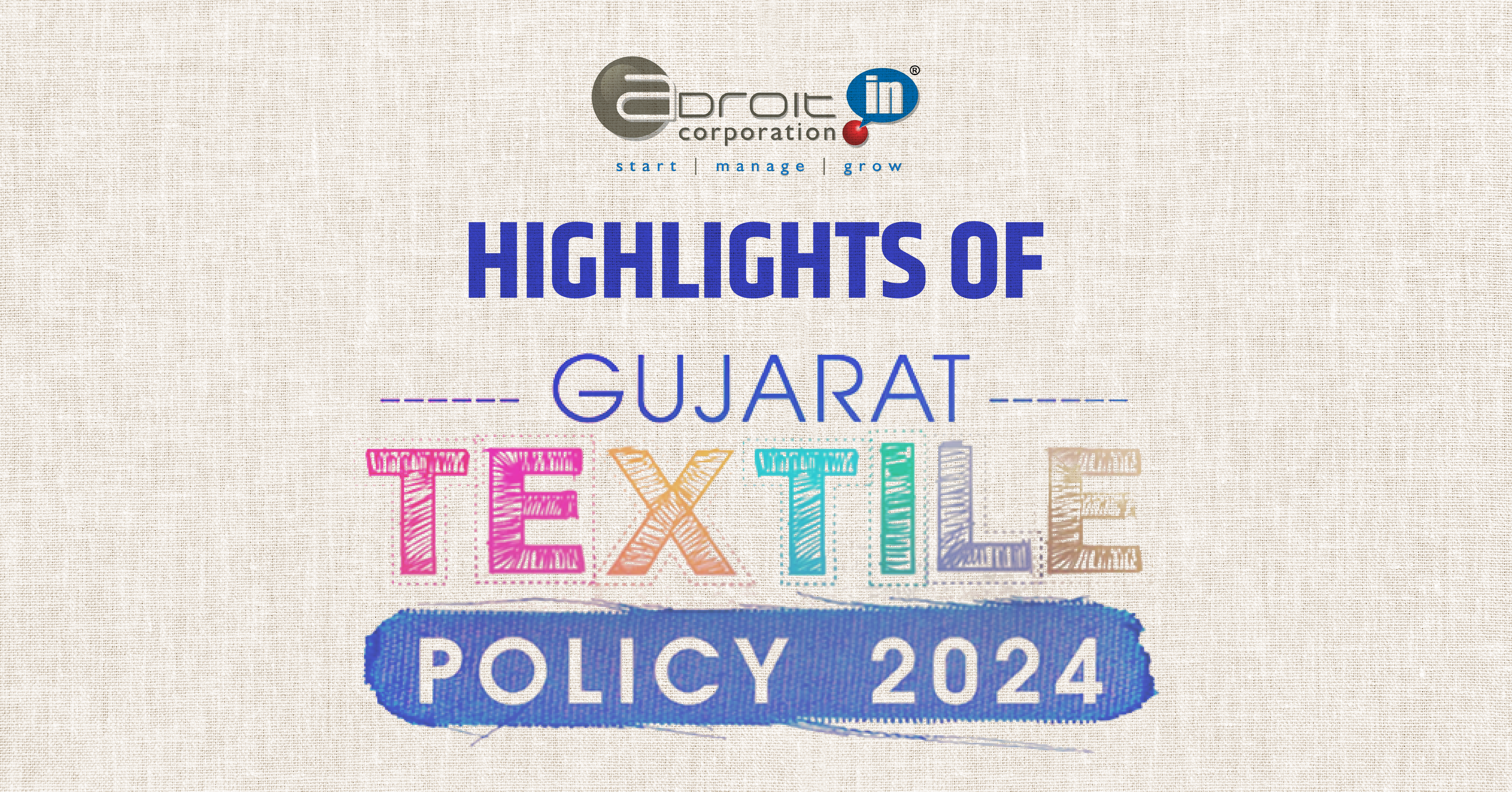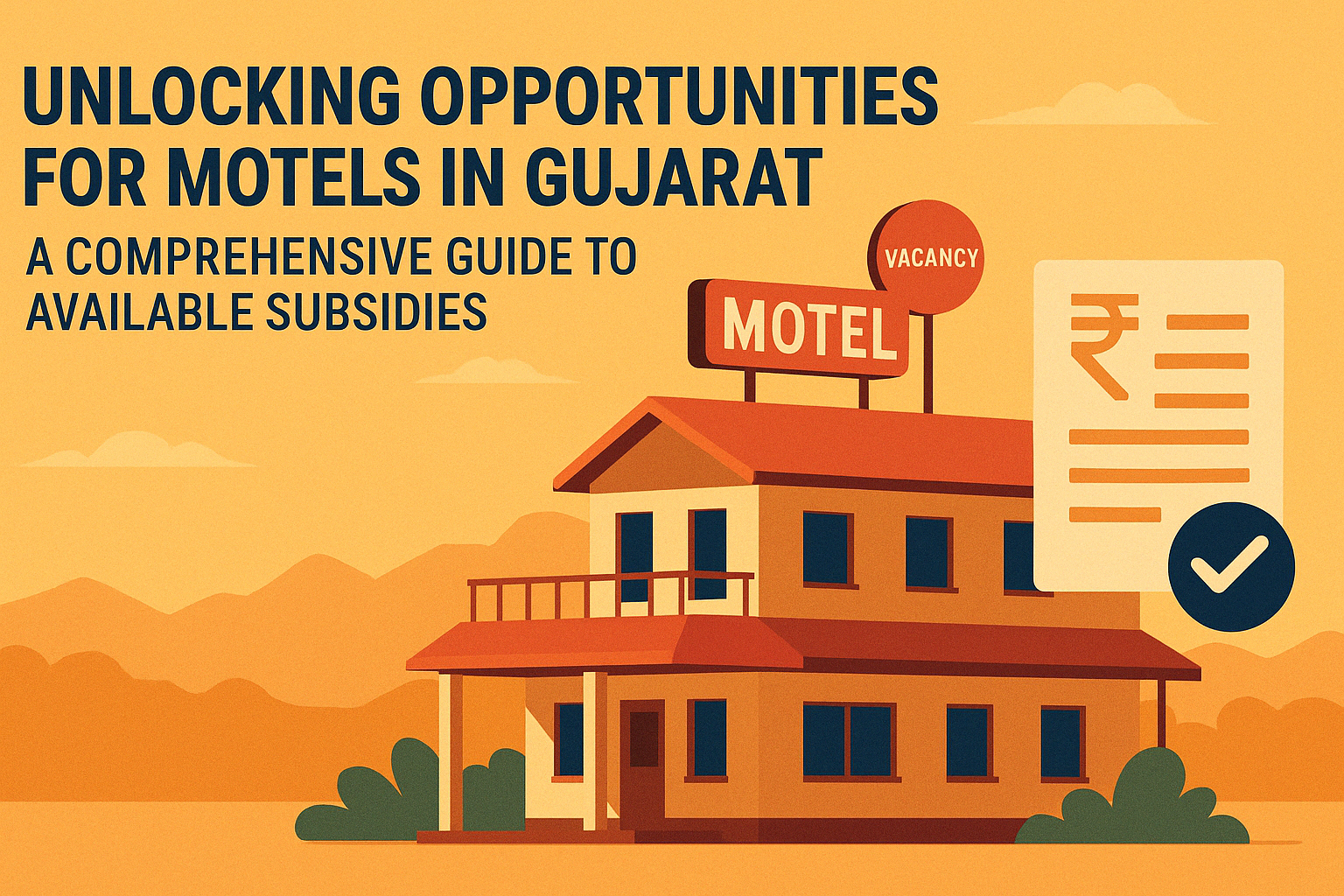
Gujarat’s Textile Policy 2024 Highlights: New Subsidies and Incentives for the Textile Sector
On October 15, 2024, the Gujarat government launched the new Textile Policy 2024, designed to further strengthen the state’s textile sector by offering comprehensive fiscal incentives and support. This policy targets the entire textile value chain, from production units to labor-intensive sectors and Self-Help Groups, with a wide array of subsidies and assistance programs. By promoting the adoption of advanced technologies, encouraging labor-intensive operations, and supporting sustainable energy usage, the Textile Policy 2024 aims to elevate Gujarat’s position as a leader in the textile industry, fostering innovation, job creation, and sustainable growth.
Textile Policy 2024 offers fiscal incentives over various areas like Textile production units, Labour-intensive units and Self-Help groups in Gujarat as follow:
Textile Production Units
List of Subsidies offered by Textile Policy 2024 to textile production units in Gujarat.
- Capital Subsidy
- Interest Subsidy
- Power Tariff Subsidy
- Payroll Assistance
- Assistance for Quality Certification
- Assistance for Saving in consumption of energy and Water
- Assistance for Technology Acquisition
Labour – Intensive Units
The policy also includes corresponding fiscal subsidy provisions for labour-intensive units.
- 25% to 35% Capital Subsidy
- 7% Interest Subsidy for 8 years
- Payroll Assistance for 10 years
- Power Tariff Subsidy
Self Help Groups
- Training Assistance Rs 5000 per member for 3 Months
- Payroll Assistance Rs 5000 per member for 5 years
Eligible Activities under Textile Policy 2024
Activity 01:
Activities focused upon by this policy include garments, apparel, made-ups, and other technical textile activities (including composite units).
Activity 02:
Weaving (with or without preparatory), knitting, dyeing & processing, texturizing, twisting, MMF Spinning to manufacture yarn from Polyester Staple Fiber (PSF) or Viscose Staple Fiber (VSF) (excluding spinning activity of cotton and synthetic filament yarn), and embroidery, are included as another activity which is focused upon by this policy.
Textile Production Units
- Capital Subsidies:
| Category of Taluka | Activity – I | Activity – II |
| Category – 1 & PM Mitra Park | 35% eFCI, Maximum Rs. 100 Crore | 20% eFCI, Maximum Rs. 100 Crore |
| Category – 2 | 30% eFCI, Maximum Rs. 100 Crore | 18% eFCI, Maximum Rs. 100 Crore |
| Category – 3 | 20% eFCI, Maximum Rs. 50 Crore | 10% eFCI, Maximum Rs. 50 Crore |
Capital subsidies will be offered ranging from 10% to 35% of the Eligible Fixed Capital Investment (EFCI – investments in fixed assets that qualify for tax benefits under government schemes). Maximum subsidy will be up to ₹100 crore based upon the taluka category and activity.
- Interest Subsidy:
| Category of Taluka | Activity – I | Activity – II |
| Category – 1 & PM Mitra Park | @7% on Term Loan for 8 Years; Maximum 3% of eFCI per annum | @7% on Term Loan for 7 Years; Maximum 2% of eFCI per annum |
| Category – 2 | @7% on Term Loan for 8 Years; Maximum 2.5% of eFCI per annum | @7% on Term Loan for 7 Years; Maximum 2% of eFCI per annum |
| Category – 3 | @5% on Term Loan for 6 Years; Maximum 2% of eFCI per annum | @5% on Term Loan for 5 Years; Maximum 2% of eFCI per annum |
Credit-linked interest subsidy is also to be offered ranging from 5% to 7% of the EFCI, for a tenure of five to eight years. Here, the maximum subsidy offered will be from 2% to 3% of the EFCI per annum based on the taluka quantifiers.
- Power Tariff Subsidy:
a power tariff subsidy is to be provided at ₹1/unit (kWh). Units availing power either from Distribution companies (DISCOMs) or renewable power through open access for a period of 5 years from DoCP (Date of Commencement of Production) are to be eligible.
| Activity | Quantum |
| Activity – I | ₹1/unit (kWh) Availing power either from Distribution companies (DISCOMs) or renewable power through open access for a period of 5 years from DoCP (Date of Commencement of Production). |
| Activity – II |
- Payroll Assistance:
Payroll assistance ranging from ₹5,000 to ₹3,000 per female worker and ₹3,000 to ₹2,000 per male worker per month is to be provided under this policy.
| Activity | Quantum |
| Activity – I | Rs. 5000 per Female Worker & Rs. 4000 per male worker per month for a period of 5 Years. |
| Activity – II | Rs. 3000 per Female Worker & Rs. 2000 per male worker per month for a period of 5 Years. |
Self Help Groups
- Training Assistance
Rs. 5000 per month per member for a period of 3 Months.
- Payroll Assistance
25% of Job work value turnover limited to Rs. 5000 per month per member for 5 years.
Labour – Intensive Units
Labour Intensive unit is a unit which providing employment to minimum 4000 employees out of which minimum 1000 are females employees.
- 25% to 35% Capital Subsidy
| Category of Taluka | Activity – I | Activity – II |
| Category – 1 & PM Mitra Park | 35% eFCI, Maximum Rs. 150 Crore | 25% eFCI, Maximum Rs. 150 Crore |
| Category – 2 | 30% eFCI, Maximum Rs. 150 Crore | 25% eFCI, Maximum Rs. 150 Crore |
| Category – 3 | 25% eFCI, Maximum Rs. 150 Crore | 25% eFCI, Maximum Rs. 150 Crore |
- 7% Interest Subsidy for 8 years
| Category of Taluka | Activity – I | Activity – II |
| Category – 1 & PM Mitra Park | @7% on Term Loan for 8 Years; Maximum 3% of eFCI per annum | @7% on Term Loan for 8 Years; Maximum 3% of eFCI per annum |
| Category – 2 | @7% on Term Loan for 8 Years; Maximum 3% of eFCI per annum | @7% on Term Loan for 8 Years; Maximum 3% of eFCI per annum |
| Category – 3 | @7% on Term Loan for 8 Years; Maximum 3% of eFCI per annum | @7% on Term Loan for 8 Years; Maximum 3% of eFCI per annum |
- Payroll Assistance for 10 years
| Activity | Quantum |
| Activity – I | Rs. 5000 per Female Worker & Rs. 4000 per male worker per month for a period of 10 Years. |
| Activity – II | Rs. 3000 per Female Worker & Rs. 2000 per male worker per month for a period of 10 Years. |
- Power Tariff Subsidy:
| Activity | Quantum |
| Activity – I | ₹1/unit (kWh) for Distribution companies (DISCOMs) or renewable power through open access or drawl of power from group captive renewable energy plant with a cap of Rs. 15 Cr/ Year for a period of 5 years from DoCP (Date of Commencement of Production). |
| Activity – II |
Conclusion:
The Textile Policy 2024 marks a significant step forward for Gujarat’s textile industry. By providing targeted financial support and incentives, the policy not only addresses current challenges faced by textile units but also positions the industry for long-term competitiveness and growth. As Gujarat continues to innovate and embrace sustainable practices, the new policy reinforces the state’s commitment to enhancing the textile sector’s global standing. This policy reflects the government’s dedication to fostering economic development, creating job opportunities, and ensuring a robust future for all stakeholders in Gujarat’s textile landscape.
Gujarat Textile Policy 2024 PDF



